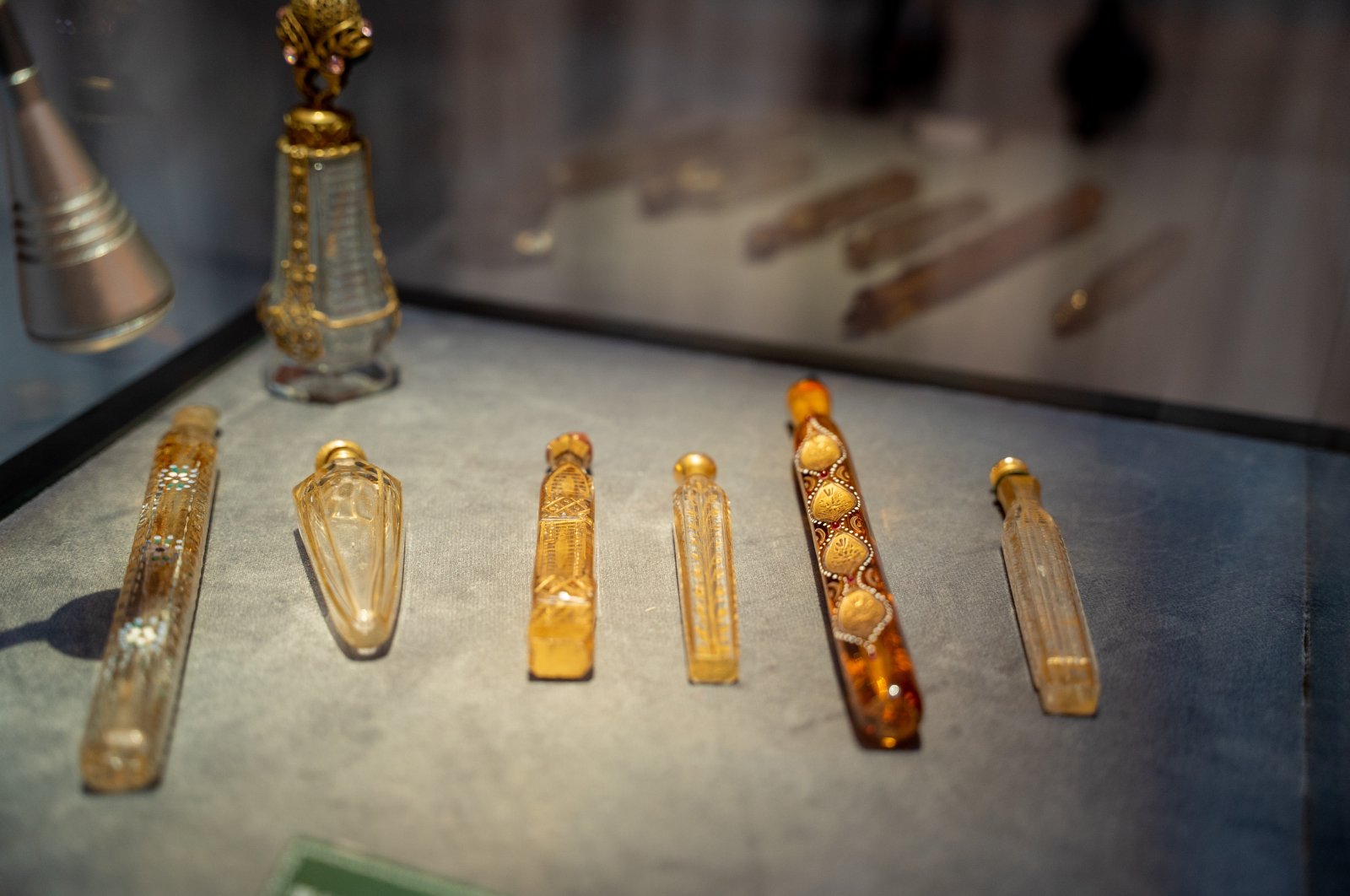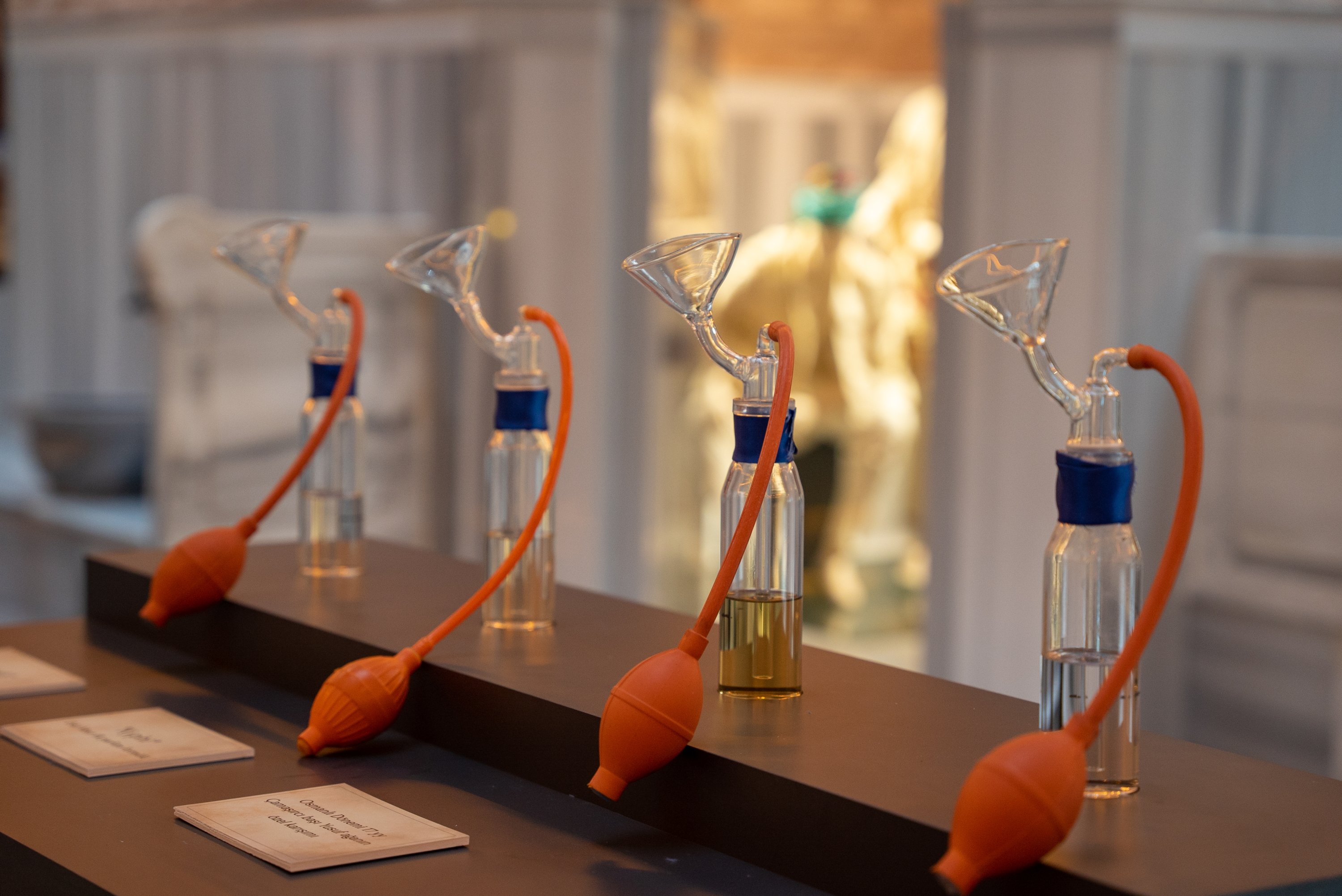
The Fragrance Culture and Tourism Association's exhibition, 'The Journey of Perfume: The History of Fragrance from Ancient Ages to the Present,' united ancient rituals, AI technology and art, delighting visitors on June 25 in Istanbul's Usküdar for World Fragrance Day
The exhibition celebrating June 25 as World Fragrance Day was a captivating event that brought together history, art and fragrance culture. Initiated by the Fragrance Culture and Tourism Association, this event went through a formal acceptance process by the U.N. to establish the day as a global celebration.
The exhibition explored the historical significance of fragrances and aromatherapy oils in various civilizations, such as ancient Rome, ancient Greece, ancient Egypt and the Ottoman Empire. Fragrance specialist and perfume designer Bihter Türkan Ergül, one of the founders of the Fragrance Culture and Tourism Association, actively participated in the event and conducted workshops on the harmony between skin types and fragrances.
Artificial intelligence (AI) was utilized to illustrate the production process, raw materials and usage methods of fragrances and essential oils in these ancient civilizations. Moreover, AI has brought historical perfume formulas dating back thousands of years to light. The exhibition also featured replicas of fragrant oil bottles used in those ancient times alongside AI-generated artworks.
The event took place in the historical Nevmekan Selimiye, a Turkish bath dating back to the 19th century. The combination of its historical and artistic value created a fascinating atmosphere for all the visitors.
Four special perfume formulas were also shown in the exhibition. Ancient Rome’s most popular formula, Mesopotamia’s first known formula, Egypt’s first known perfume formula and an exceptional formula that was very famous in Ottoman Palace were some of the focus points of the exhibition, besides many fragrances used in antiquity, like blue lotus.
Usküdar Municipality Mayor Hilmi Türkmen and Member of Parliament Belma Satır were also at the exhibition's opening ceremony.
In the opening speech, Türkmen said: "We witness an extraordinary exhibition. Because there is a Turkish bath that dates back 200 years, built by the order of Sultan Selim III. If we regard this perspective, we witness history. We thought that if that kind of exhibition would be realized, the most appropriate place was here.” Türkmen added that the Selimiye Turkish Bath was used by Ottoman soldiers, then it was left to its fate for years and Usküdar Municipality took it from the Directorate General of Foundation and transformed it into an art center and library. He said that it was the first time Nevmekan Selimiye hosted an exhibition of this kind.

On the other hand, Satır said that she was happy to see that such a cultural determinant exhibition is realized in Usküdar, where she lives.
"When I met with Bihter Türkan Ergül, I learned many things about fragrance culture, the richness of fragrance in Türkiye, and the first-ever academy on scents and fragrances. We all use perfume and we have grown up with Turkish cologne culture. After we met with Ergül in 2015, she did wonderful work and opened the first academy in the world on scents and fragrances, Koku Akademisi in Turkish. She realized many projects about fragrance in Erzurum, which is my home town, Şanlıurfa, Isparta, and so on. She talked about the richness of fragrance and the fragrance culture of Türkiye to the whole world. She made projects on fragrance in Europe. She tells the world about Turkish fragrance and perfume culture and shares this richness with us,” she said.
Gladiator’s favorite: Rhodium
In the exhibition, four special fragrance formulas from history. Rhodium, the most popular formula in Rome, was formulated with the sweat of gladiators and rose oil. Because gladiators’ sweat and dirt were seen as valuable besides their blood used in painting and sculpture.
Romans loved perfumes with a simple formula. In Antique Rome, besides rhodium with rose, narcissus, and crocus with saffron, metopium with bitter almonds was among the most loved perfume mixtures.
Romans loved simple perfumes: rhodium with rose, melissa with quince, metopium with bitter almonds, narcissus, and crocus with saffron, but also more complex compositions such as cyprium with henna flowers, nardicum based on costus, nard, and myrrh. These products were sold in the "incense district” called Victus Thuraricus in Rome and were favorite fragrances. Among the most esteemed fragrance, Rose and Nard were always favorites.
1st chemist of Mesopotamia: Tapputi
The other formula starred in the exhibition was Mesopotamia’s first known formula inscribed on a clay tablet by Tapputi. Tapputi is the first known chemist; she is also the first known woman chemist. Named after the famous chemist Tapputi who lived in Mesopotamia 4,000 years ago and served the Babylonian kingdom as a chemist by producing healing mixtures fragrances, this fragrance cracks the door of the fragrance culture of Mesopotamia.
The oil blend reflects the value of a treasure of thousands of years to its scent. Tapputi contains iris flower, saffron extract, labdanum, vetiver, pepper, white musk, resin and frankincense. Each flower used has a beautiful story in mythology and some spiritual functions and medical benefits used by the Ancient civilization, especially by the upper classes in these civilizations.
We see many of the ingredients in the formula have mythological stories in many cultures like ancient Greece mythology; the Iris flower could absorb the water from the earth to feed the cloud, and while doing that, the rainbow, which was seen as the link between heaven and earth was rising. So, Iris was one of the goddesses in ancient Greek mythology. As Iris personified the rainbow, the Iris flower was planted over women's graves because they believed the rainbow, which is the Greek word for "Iris," could lead them to heaven.
Saffron flowers, derived from the Crocus sativus plant, represent innocence, new beginnings, joy and rebirth. In Greek mythology, Crocus was a beloved companion of Hermes and he was killed accidentally by Hermes. As Hermes mourned for Crocus, the dead body of Crocus transformed into a flower. Saffron is also precious for other civilizations. In the Middle Ages, the death penalty punished anybody who got involved in fraud about Saffron. Saffron benefited in many fields like cuisine, textile, and cosmetics.
According to fragrance curator Brooke Belldon: "It’s mentioned in the Bible’s Book of Genesis and some scholars believe it also has ties to the Torah. Specialists on ancient Egypt think the false beards worn by Osiris and the pharaohs were actually labdanum-laden goat’s beards.” In ancient times, labdanum was collected by combing the thighs and the beards of goats and sheep grazing on cistus. The resin of labdanum was used to treat coughs, colds, rheumatism, and menstrual problems. In the Book of Genesis, labdanum was transferred from Palestine to Egypt.
It is an exceptional occasion for visitors to experience that fragrance whose formula is on a clay tablet.
Ancient Egypt’s 1st formula: Kyphi
Kyphi is Egypt’s first known perfume formula. Kyphi is the world’s oldest fragrance formula, unearthed from the mysterious labyrinths of Egypt.
According to the information written on the walls of the pyramids, Kyphi, which was prepared as a paste, consisted of a mixture of honey, grapes, wine, rice, myrtle, saffron, juniper and olive oil. This mystical mixture, which was used both by applying to the hair and burning in the fire, was also kept secret by the priests. The content, kept like a secret, consisted of 13 mixtures.
In the exhibition, the example of Kyphie was prepared according to the old formula. The question "if Cleopatra was alive, how would Cleopatra’s perfume smell today?” was a beginning point and Cleopatra’s fragrance usage habits were good clues to construct the formula. As Cleopatra is an influential figure who shaped an important part of world history, every note in the Kyhpie’s formula has mystical fragrances in antiquity: Frankincense which empowers the senses, oud which has a collapsing effect and murr, which has a mysterious breeze and charismatic oud. Kyphi perfume represents the sun and myrrh represents the moon. The moon symbolizing the feminity comes together with the sun symbolizing masculinity in the formula. The formula of Kyphie in the exhibition has all these archeological and spiritual inspirations. Kyphie’s formula has red rose and lotus in the top note, Isparta rose in the heart note and black oud, oud and murr in the base note.
The last fragrance is a special mixture of Çamaşırcıbaşı (laundry officer) Yusuf Aga, who worked in the Ottoman Palace in the 17th century.
‘AI meets smell’
Stating that the journey of AI and fragrance meets with this exhibition, fragrance expert and famous perfume designer Bihter Türkan Ergül whose perfume designs are inscribed in Fragrantica, said: "With this exhibition, we aimed to upload the information in clay tablets, replicas and manuscripts that archaeologists are working on, to AI and bring it to light. Thus, we embarked on an AI journey where we searched for answers to questions such as ‘How was a fragrance designed in Egypt, Rome, Mesopotamia, and the Ottoman Empire?’ how were the commercial relations between fragrance and aromatic oils? how was the fragrance trade carried to port cities?’ The information we obtained from AI was also combined with the information in manuscripts and clay tablets, and a magnificent exhibition emerged. There is not only visuality in our exhibition but also art and fragrance.”
Ancient formulas
Pointing out that in the exhibition, besides the visualization of the production, production and raw materials of scents from the ancient age with AI, a real scent experience was brought together with scent lovers, Ergül said.
"Our visitors will be able to experience the scent here; we have fragrance formulas that are 3,000, 5,000, 8,000 years old and some belong to the 17th century of the Ottoman Empire. The formula was made by the laundry officer and the exact recipe for ‘bukhur suyu’ is in a notebook of the officer was found in the archives of Topkapı Palace and dates back to 1708. We designed the fragrance based on and from that formula. The perfume was designed from a mixture of fragrances prepared for Nefertem, known as the ancient Egyptian goddess of perfume; the fragrance formula of Tapputi, the Kypi formula in ancient Egypt and the most popular Rhodium perfume in Rome are waiting for its visitors in our exhibition.”
Different dimension
In his speech, the exhibition's curator of Usküdar Municipality, Erkan Doğanay said: "We wanted to coincide the opening of our exhibition with World Fragrance Day. We prepared our exhibition with a presentation that we can support with documents and objects with which we can tell the history of fragrance by creating some areas of experience. The exhibition, which met with the historical place, gained a different dimension. Here, not only a visual or object presentation of the scent and fragrance but also a presentation where visitors can smell and watch past scents emerge. Talks and workshops await fragrance enthusiasts during the exhibition.”
Day registered by UNESCO
The recent decision by the Intangible Cultural Heritage Specialization Committee of the UNESCO Turkish National Commission to examine and endorse the application made by the Fragrance Culture and Tourism Association represents a significant milestone in promoting the worldwide celebration of World Fragrance Day. This recognition underscores the cultural importance and heritage of fragrances, marking a significant stride toward establishing World Fragrance Day as a cherished event internationally.
With the responsibility for the follow-up process of registering World Fragrance Day now transferred to the Ministry of Culture and Tourism of Türkiye, there is a strong commitment to ensuring the success and acknowledgment of this special occasion.
